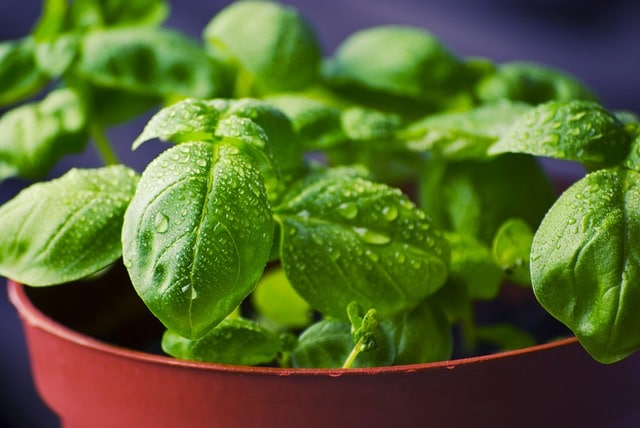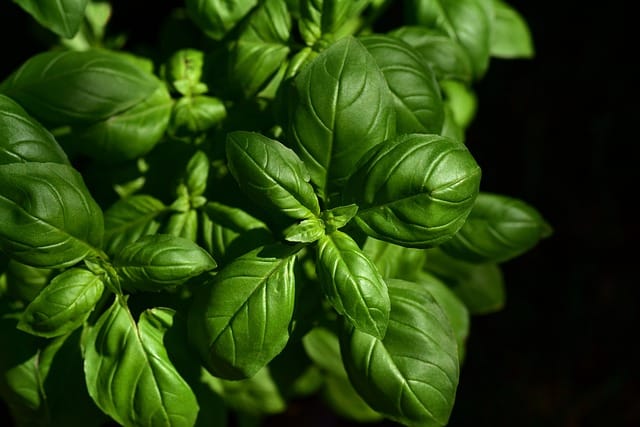Introduction – Homegrown Basil and Heat Tolerance
Basil is an herb that is a member of the mint family.. It is one of the more popular herbs used in the kitchen. It is grown from seed and prefers to grow in warm weather. Basil heat tolerance is a little higher than that of vegetables.
Basil grows well in full sun or partial shade. The plant will grow between two to three feet tall; it must be planted at least three feet apart and can take up to six inches of rain per week.

Basil Heat Tolerance
The most healthy and productive temperature is the following: 27 to 32 degrees C (80 to 90 F). In fact, a Basil planting can still be productive at temperatures as high as 35 degrees C (95 F).
For germination, Basil prefers temperatures between 15-18 degrees C (60-65F) at night. It matures rapidly during warm weather, so you want it to be happy immediately!
We have generated an organized table below for ideal temperature ranges in different aspects of growing basil.
| Aspect | Ideal Condition |
|---|---|
| Growing Temperature | 27 to 32 degrees C (80 to 90 F) |
| Maximum Heat Tolerance | Up to 35 degrees C (95 F) |
| Germination Temperature | 15-18 degrees C (60-65 F) at night |
| Soil Type | Well-draining yet consistently moist |
| Soil pH | Around 5.8 |
| Sunlight Exposure | At least 6 hours of full sun daily |
Basil can survive heat better than vegetables. Some of its close relatives, such as sage and oregano, will wilt in the hot sun and need shade, or their leaves may burn.
Ideal soil conditions for basil are well-draining yet moist, with a pH of 5.8. If your soil is too acidic, add lime to adjust the pH before planting seeds or seedlings in your garden. Basil also requires six hours of full sun a day for optimum growth.
The acidity of the soil is tested using a soil acidity tester. These are available online and at home improvement stores.
How Hot Is It Too Hot For Basil? – Heat Waves
As we noted above, the ideal temperature range for growing basil is between 80 and 90 degrees Fahrenheit. High temperatures, particularly above 95 degrees Fahrenheit, can cause heat stress in basil plants and lead to wilting, browning, or other signs of damage.
The great heat wave of 2023 made of lot of basil wilt and die. In such extreme cases, when ambient temperatures are pushing over 100 degrees Fahrenheit for weeks on end mean drastic action – bringing your basil indoors, might be the only solution!
Weather conditions may reduce the plant’s ability to produce essential oils that give basil its characteristic flavor and aroma.
If you are experiencing unusually high temperatures in your garden, you can do a few things to protect your basil plants. For example, you can provide them with plenty of shade and water during the hottest part of the day.
You may also consider using organic mulch or installing a shade structure over your garden bed to minimize sun exposure and help maintain a more comfortable growing environment for your basil plants. First, lets recognize what is high temperatures with respect to basil.
Symptoms Of Excessive Heat In Basil
- Wilting or Drooping Leaves: Especially noticeable during the peak heat of the day.
- Change in Leaf Color: Leaves may turn yellow or brown.
- Crisp Edges: The edges of the leaves may become crisp or burnt looking.
- Leaf Drop: Heat-stressed plants may drop leaves.
- Loss of Flavor and Aroma: The characteristic robust flavor and aroma of basil can diminish.
Second, lets figure out what to do to fix it.
Course Of Action To Correct Excessive Heat
Once you’ve identified that your basil plant is suffering from excessive heat, immediate action is imperative to restore its vitality. Basil plants thrive in warm conditions, but like all plants, there is a limit to the heat they can withstand.
- Provide Shade: Protect your basil plants from the peak heat of the day with a shade cloth or similar.
- Ample Water: Ensure your basil plants receive sufficient water but avoid waterlogging.
- Mist: Create a cooler, humid environment.
- Mulch: Mulching around your plants can help keep the roots cool and retain soil moisture.
- Drip Irrigation System: If the heat is accompanied by drought, a drip irrigation system can provide consistent watering.
- Monitor and Care: Heat-stressed plants can recover with your attentive care.
Extreme Temperature Events – What To Do
Common sense plays a crucial role in plant care, especially during extreme weather conditions.
If the temperature soars to 100 degrees, which is far beyond the ideal range for most plants, including basil, immediate steps must be taken to protect the plant’s health.
During the summer of 2023 this is in fact happening across large swathes of the US. The simplest and most effective action would be to bring the plant indoors where the temperature is more controlled.
Position the plant near a window where it can still get plenty of sunlight, but not direct heat. Common sense, paired with a basic understanding of your plant’s needs, can go a long way in ensuring its health and longevity.
Growing Basil

When growing basil, it is important that you have good soil drainage with plenty of nutrients. It is important to ensure they get enough water and food to get the most leaves from your plants.
The water and food depend on how much sun your basil gets during the day and how often the plant is watered. If you want larger leaves, prune off any flower buds as soon as they appear.
This will cause the plant to put more energy into leaf production than seed production and will also mean fewer seeds in your garden next year!
To prune basil, pinch off branches just above where two or more leaves join together using your fingers. It is a good idea to start pruning your basil as soon as you plant it so that the plant has time to get going and produce lots of leaves.
If your basil gets too hot one day and starts wilting, try moving it into an area with more shade for a few hours or until the sun goes down. Wrapping the leaves in damp paper towels and then placing them in a box will help cool the leaves on hot days and can increase the growth of new leaves!
Overall, basil does well when grown under warm conditions with plenty of sun and water. With proper care, you can enjoy fresh basil all season long.
How To Prevent Cold Damage To Basil?
One of the biggest challenges for basil growers is preventing cold damage to their plants, as basil is sensitive to temperatures below 50 degrees Fahrenheit.
One way to prevent cold damage is to bring potted basil indoors during colder weather, particularly at night. Another option is to cover basil plants with a thick layer of mulch or a blanket.
Gardeners can plant their basil in raised beds to ensure better drainage and protection from cold winds.
Timing of planting and harvesting wisely can help reduce the risk of cold damage on basil plants – avoid planting too early in spring and wait until the danger of frost has passed, and harvest all leaves before the first frost in fall.
These methods allow gardeners to enjoy delicious and plentiful basil throughout the growing season without fear of cold damage.

The Symptoms Of Cold Damage On Basil
Excessive exposure to cold temperatures can cause the leaves of basil plants to turn brown and appear wilted. You may also notice dead or discolored spots on the leaves, which can signify disease or frost damage.
If you suspect cold damage on your basil plants, check for pests or other signs of disease. This can help you identify the underlying cause of the problem and take corrective action to prevent further damage. If possible, move affected basil plants to a warmer location until they have recovered.
If the symptoms are more severe, give it cold care. Move the plants to a warmer location and gradually reduce watering, as excess water can further stress a cold-damaged plant. At the same time, ensure the soil is well-draining to prevent waterlogging.
Basil is one of the most important ingredients in Mediterranean cooking, especially in Italian cuisine. It adds flavor to pasta dishes, sauces, soups, stews, and pizza.
Large leaves are often cut into chiffonade, which means they are rolled into tight bundles and then sliced thinly for use in salads like caprese salad and tomato with mozzarella cheese.
Smaller leaves are also popularly used as an herb for garnishing dishes such as fresh fruit salads, ice cream, and carbonara.
Wrapping Up
In conclusion, it is important to keep your basil plants cool and well-hydrated on hot days to prevent heat stress and other signs of damage. With proper care, you can enjoy delicious and flavorful basil all season long, even under hot conditions!
